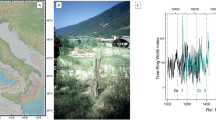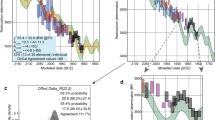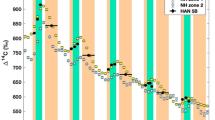Abstract
USING dendrochronologically dated tree rings de Vries1 showed that the atmospheric 14C concentration has not been entirely constant during the past few hundred years. By extending the North American bristlecone pine tree-ring chronology2 to nearly 8,000 yr ago, several radiocarbon laboratories succeeded in measuring deviations in the 14C concentration from the mid-nineteenth century natural 14C level to a maximum of about 10% around 4000 BC (refs 3–7). Superimposed on this general trend, Suess drew with ‘cosmic schwung’, medium-term variations through his data. These so-called ‘wiggles’ should correspond with variations in the abundance of radiocarbon in atmospheric carbon dioxide on a time scale between one decade and a few centuries. The resulting irregular shape of Suess' calibration curve has been questioned during the past few years8,9. The overall result, however, is that no generally accepted 14C calibration curve is yet available. It would be most convenient to measure 14C concentrations in single tree rings with much higher precision than the usual 4–6‰. For this, however, much larger samples are required than are available from the bristlecone pine tree. An excellent opportunity was presented by the sub-fossil oak trunks discovered in the river valley sediments of southern Germany9; our measurements of these trunks are reported here.
This is a preview of subscription content, access via your institution
Access options
Subscribe to this journal
Receive 51 print issues and online access
$199.00 per year
only $3.90 per issue
Buy this article
- Purchase on Springer Link
- Instant access to full article PDF
Prices may be subject to local taxes which are calculated during checkout
Similar content being viewed by others
References
de Vries, H. L. Kon. Ned. Akad. Wet. Proc. B61, 94–102 (1958).
Ferguson, C. W. Proc. 8th int. Conf. Radiocarbon Dating, Al-11 New Zealand (1972).
Damon, P. E., Long, A. & Wallick, E. I. Proc. 8th int. Conf. Radiocarbon Dating, A28–44 (1972).
Ralph, E. K. & Michael, H. N. 12th Nobel Symp., 237–245 (1970).
Suess, H. E. Radioactive Dating and Methods of Low Level Counting, 143–151 (IAEA Vienna, 1967).
Suess, H. E. Radiocarbon 20, 1–17 (1978).
Suess, H. E. Proc. 9th int. Radiocarbon Conf. UCLA and UCSD (in the press).
Clark, R. M. & Renfrew, C. Archaeometry 14, 5–19 (1971).
Pearson, G. W., Pilcher, J. R., Baillie, M. G. L. & Hillam, J. Nature 270, 25–28 (1977).
Becker, P. Proc. IXth int. Radiocarbon Conf. UCLA and UCSD (in the press).
Tans, P. P., de Jong, A. F. M. & Mook, W. G. Nature 271, 234–235 (1978).
Tans, P. P. & Mook, W. G. Radiocarbon (in the press).
Suess, H. E. & Becker, B. Proc. Symp. Die Dendrochronologie des Postglazials, 156–170 (Akad. d. Wiss. Mainz 1977).
Author information
Authors and Affiliations
Rights and permissions
About this article
Cite this article
DE JONG, A., MOOK, W. & BECKER, B. Confirmation of the Suess wiggles: 3200–3700 BC. Nature 280, 48–49 (1979). https://doi.org/10.1038/280048a0
Issue Date:
DOI: https://doi.org/10.1038/280048a0
This article is cited by
-
Prolonged minima and the 179-yr cycle of the solar inertial motion
Solar Physics (1987)
-
Solar variability and climatic change during the current millennium
Nature (1980)
Comments
By submitting a comment you agree to abide by our Terms and Community Guidelines. If you find something abusive or that does not comply with our terms or guidelines please flag it as inappropriate.



